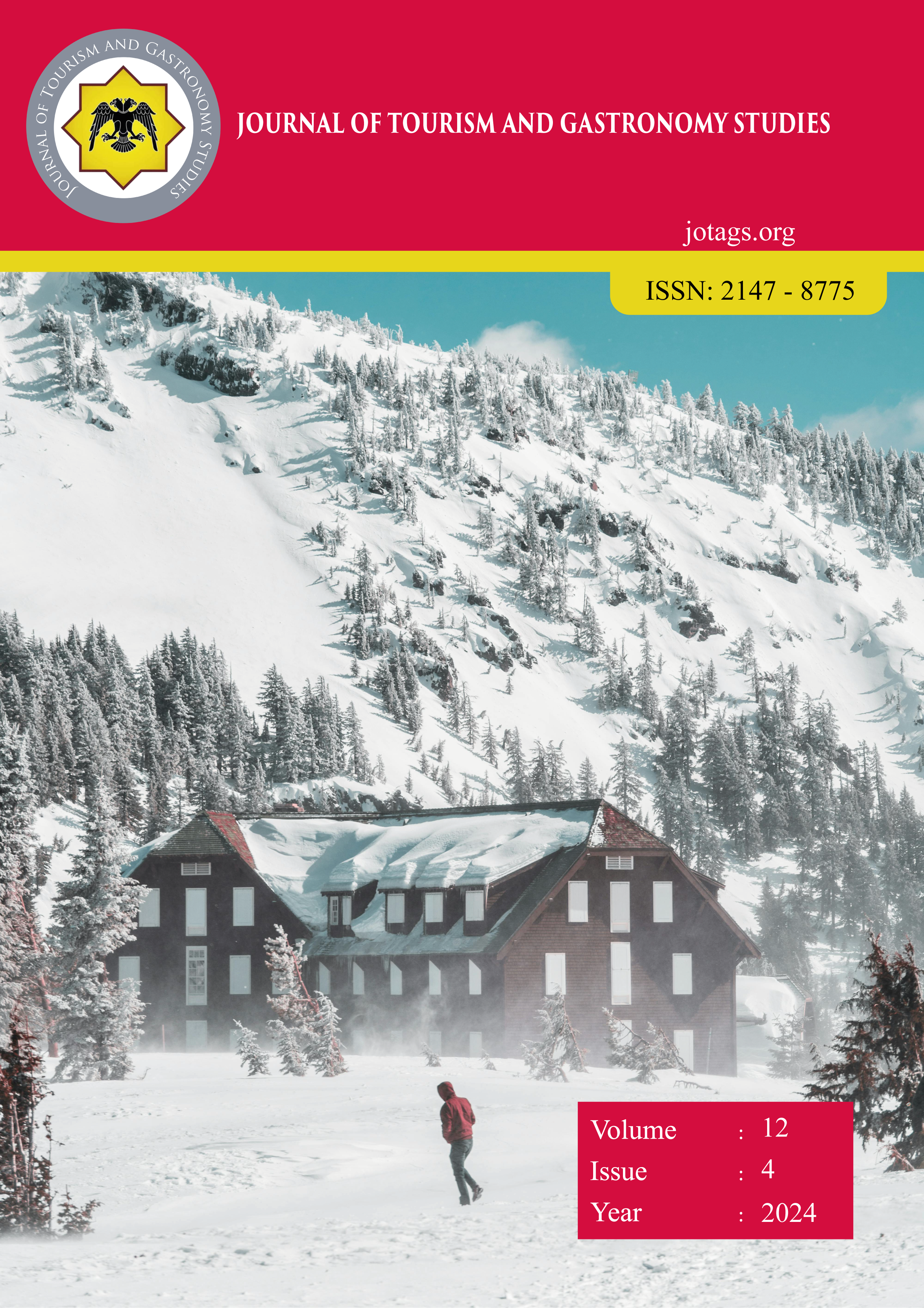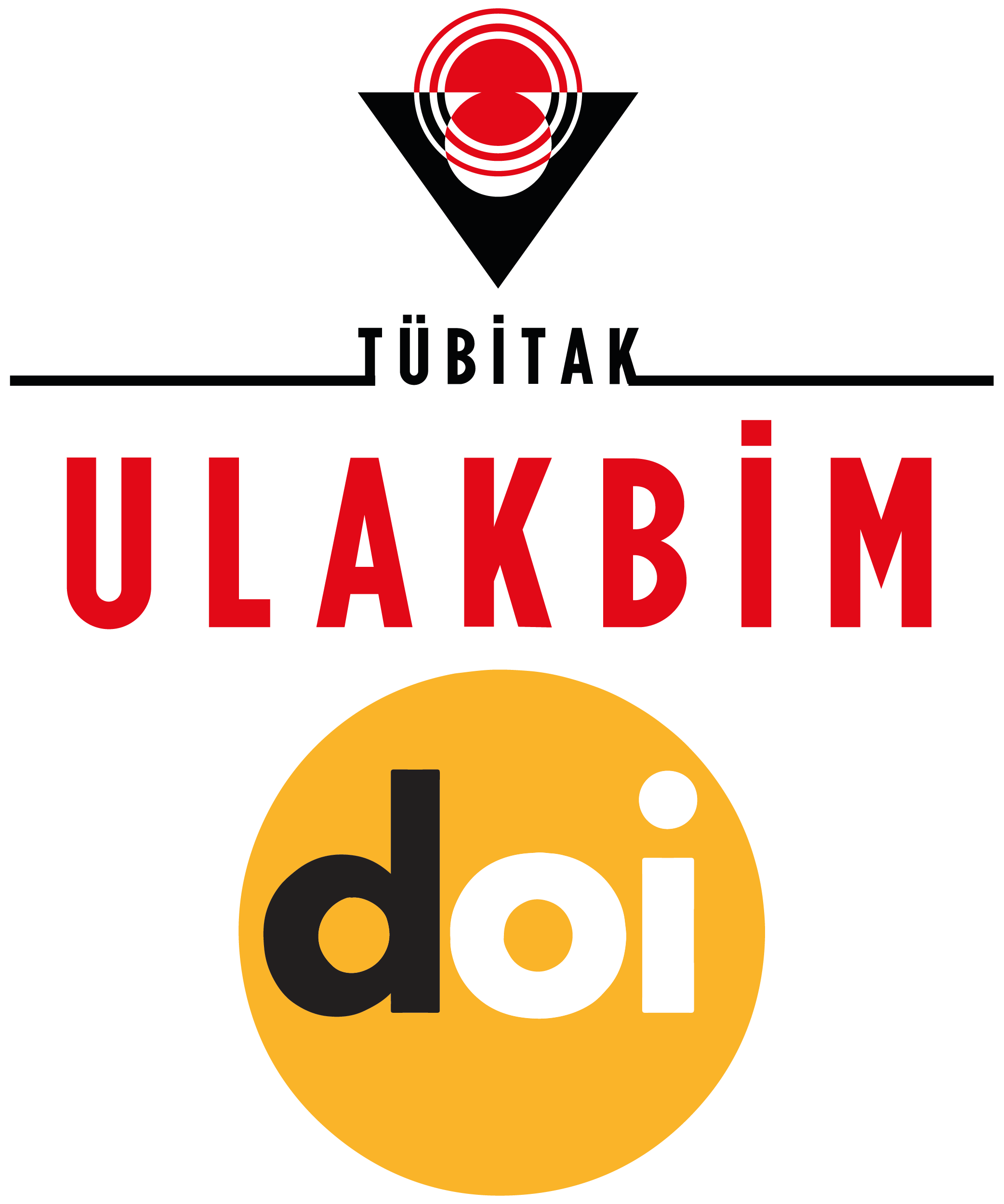Gastronomi/Gastronomik, Mutfak ve Yemek Turizmi: Kavramlar Arasında Bir Ayrım ve Tartışma (Gastronomy/Gastronomic, Culinary, and Food Tourism: A Conceptual Distinction and Discussion)
DOI:
https://doi.org/10.21325/jotags.2024.1537Keywords:
Gastronomy/Gastronomic tourism, Food tourism, Culinary tourismAbstract
The increase in tourism activities has been accompanied by a significant rise in travels focused on culinary culture. With the influence of social media platforms and food television programs featuring world-renowned chefs, restaurants and events, food and food-related travel has become mainstream. In Turkey, especially after 2010, there has been a significant increase in the number of institutions and academics providing education in this field with the growing interest in cooking and gastronomy and culinary arts education. This situation has also contributed to an increase in the number of academic studies in the related field. While it is seen that the majority of the studies published in the TR Index journal list in Turkey are concentrated under the title of “gastronomy tourism” (99%), it has been determined that researchers in the international literature address the title of the study with different titles such as “gastronomy / gastronomic tourism” (29%), “food tourism” (46%) and “culinary tourism” (25%). In this context, the main purpose of the study is to evaluate the contribution of these concepts to the literature by examining the usage areas of these different headings used in foreign literature. The results of the research show that the term “gastronomy tourism” can be widely used in studies on eating and drinking behaviors in general, while the definitions of “culinary tourism” and “food tourism” are more clear, limited and understandable.
References
Ab Karim, S., & Chi, C. G. Q. (2010). Culinary tourism as a destination attraction: An empirical examination of destinations' food image. Journal of Hospitality Marketing & Management, 19(6), 531-555.
Albayrak, A. (2022). Evaluation of gastronomy education quality in Turkey in terms of faculty members. International Journal of Gastronomy and Food Science, 28, (100498), 1-8.
Aria, M., & Cuccurullo, C. (2022). Biblioshiny bibliometrix for no coders. https://bibliometrix.org/biblioshiny/assets/player/KeynoteDHTMLPlayer.html Erişim Tarihi: 5 Eylül 2023.
Ateş, A., & Sunar, H. (2022). Yöresel mutfakların gastronomik markalaşması, Prof. Dr. Mete Sezgin, Öğr. Gör. Abdullah Köseoğlu. (Ed.), Turizm Sektöründe Markalaşma Analizler, Sorunlar, Çözümler içinde (s. 313-326). Konya: Eğitim Yayınevi
Balderas-Cejudo, A., Patterson, I., & Leeson, G. W. (2019). Senior Foodies: A developing niche market in gastronomic tourism. International Journal of Gastronomy and Food Science, 16, 100152.
Bertan, S. (2020). Impact of restaurants in the development of gastronomic tourism. International Journal of Gastronomy and Food Science, 21, 100232.
Björk, P., & Kauppinen-Räisänen, H. (2014). Culinary-gastronomic tourism–a search for local food experiences. Nutrition & Food Science, 44(4), 294-309.
Bodenham, D. (1993). The food dictionary, Bristol: Redcliffe Press,
Boniface, P. (2003), Tasting Tourism: Travelling for Food and Drink, Ashgate, Aldershot, London: Routledge
Boyne, S., Williams, F., & Hall, D. (2002). The Isle of Arran taste trail, In: Hjalager, A.- M., & Richards, G. (Eds.). Tourism and Gastronomy, (pp. 91–114). London: Routledge.
Britannica.com, (2024a). Gastronomy, https://www.britannica.com/search?query=gastronomy Erişim: 15.04.2024.
Britannica.com, (2024b). Food, https://www.britannica.com/topic/food Erişim: 15.04.2024.
Canadian Tourism Commission. (2002). Acquiring a Taste for Cuisine Tourism. A Product Development Strategy. Canadian Tourism Commission. Ottwa. https://publications.gc.ca/collections/collection_2008/ic/Iu86-24-2002E.pdf Erişim: 14.04.2024.
Chaney, S., & Ryan, C. (2012). Analyzing the evolution of Singapore's World Gourmet Summit: An example of gastronomic tourism. International Journal of Hospitality Management, 31(2), 309-318.
Cohen, E., & Avieli, N. (2004). Food in tourism: Attraction and impediment. Annals of Tourism Research, 31(4), 755–778.
De Albuquerque Meneguel, C. R., Mundet, L., & Aulet, S. (2019). The role of a high-quality restaurant in stimulating the creation and development of gastronomy tourism. International Journal of Hospitality Management, 83, 220-228.
Dean, S. (2013). The Etymology of the Words 'Food' and 'Meal', https://www.bonappetit.com/test-kitchen/ingredients/article/the-etymology-of-food-and-meal Erişim: 18.04.2024.
Derek, A. P. (1996). International Food Dictionary, United Kingdom: Summersdale Publishers.
Dictionary.com (2024). Gastronomy, Gastronomic, Food and Culinary. https://www.dictionary.com/
Erişim: 12.04.2024.
Dictionary.cambridge.org. (2024a). Culinary, https://dictionary.cambridge.org/dictionary/english/culinary Erişim: 15.04.2024.
Dictionary.cambridge.org. (2024b). Vocational, (Gastronomy, Gastronomic, Food and Culinary) https://dictionary.cambridge.org/dictionary/english/vocational Erişim: 15.04.2024.
Durgun Kaygısız, A. (2023). Türkiye Cumhuriyeti’nin 100. yılında turizm. Bilge Uluslararası Sosyal Araştırmalar Dergisi, 7(2), 124-133.
Durmaz, Y., Çayırağası, F., & Çopuroğlu, F. (2022). The mediating role of destination satisfaction between the perception of gastronomy tourism and consumer behavior during COVID-19. International Journal of Gastronomy and Food Science, 28, 100525.
Ellis, A., Park, E., Kim, S., & Yeoman, I. (2018). What is food tourism?. Tourism Management, 68, 250-263.
Everett, S., & Aitchison, C. (2008) The Role of Food Tourism in Sustaining Regional Identity: A Case Study of Cornwall, South West England, Journal of Sustainable Tourism, 16:2, 150-167.
Fusté-Forné, F. (2021). Robot chefs in gastronomy tourism: what's on the menu?. Tourism Management Perspectives, 37, 100774.
Gómez de Silva, G. (2003). International Dictionary of Gastronomy, New York: Hippocrene Books
Hall, C.M. (2003), Wine, food and tourism marketing, New York: The Haworth Hospitality Press.
Hall, C. M. & Mitchell, R. (2001). Wine and Food Tourism. Douglas, N., Douglas, N. and Derrett, R., (Eds.), Special Interest Tourism: Context and Cases (pp. 307–329). Wiley.
Hall, C. M., & Sharples, L. (2003). Food Tourism Around the World. Hall, C. M., Sharples, L. Mitchell, R. Macionis, N. & Cambourne, B. (Ed.), The consumption of experiences or the experience of consumption? An introduction to the tourism of taste, (pp. 1-24). Butterworth-Heinemann: Oxford.
Hall, C.M., Sharples, L., Cambourne, B., & Macionis, N. (2000), Wine Tourism Around The World: Development, Management and Markets, (1st ed.). London: Routledge.
Hall, C. M., Sharples, L., Mitchell, R., Macionis, N., & Cambourne, B. (2003). Food tourism around the world: Development, management and markets. Routledge. https://books.google.com.tr/books?hl=tr&lr=&id=WGgABAAAQBAJ&oi=fnd&pg=PP1&dq=Food+tourism+around+the+world:+Development,+management+and+markets&ots=NSQ63WPPJE&sig=iJZ836ysvqJF6nZ4f4jH142QiIc&redir_esc=y#v=onepage&q=Food%20tourism%20around%20the%20world%3A%20Development%2C%20management%20and%20markets&f=false Erişim Tarihi: 15.04.2024.
Henderson, J. C. (2009). Food tourism reviewed. British Food Journal, 111(4), 317-326.
Hjalanger, A.M., & Richards, G. (2002). Tourism and Gastronomy, London: Routledge.
Horng, J. S., & Tsai, C. T. S. (2010). Government websites for promoting East Asian culinary tourism: A cross-national analysis. Tourism Management, 31(1), 74-85.
Kivela, J., & Crotts, J. C. (2005). Gastronomy Tourism: A Meaningful Travel Market Segment. Journal of Culinary Science & Technology, 4(2–3), 39–55.
Kumar, G. M. K. (2019). Gastronomic tourism—A way of supplementing tourism in the Andaman & Nicobar Islands. International Journal of Gastronomy and Food Science, 16, 100139.
Long, L. M. (Ed.). (2004). Culinary tourism. University Press of Kentucky. https://books.google.com.tr/books?id=8WkumSPd7acC&printsec=frontcover&hl=tr&source=gbs_ge_summary_r&cad=0#v=onepage&q&f=false Erişim Tarihi: 10 Nisan 2024
Marlina, L., Rusydiana, A.S., Hidayat, P., & Firdaus, N. (2021). Twenty years of Islamic banking in Indonesia: A biblioshiny application. Library Philosophy and Practice (ejournal), 4999.
Mason, M. C., & Paggiaro, A. (2012). Investigating the role of festivalscape in culinary tourism: The case of food and wine events. Tourism Management, 33(6), 1329-1336.
Massimo, A., & Corrado, C. (2023). Biblioshiny bibliometrix for no coders. https://www.bibliometrix.org/biblioshiny/ Erişim Tarihi: 18 Kasım 2024
Nigar, A. (2020). Slow Food Hareketinin Gastronomi Turizminin Sürdürülebilirliği ile İlişkisi: Foça Örneği, [Yayımlanmamış Yüksek Lisans Tezi]. İzmir: Dokuz Eylül Üniversitesi.
Oxfordlearnersdictionaries.com. (2024a). Culinary, https://www.oxfordlearnersdictionaries.com/definition/english/culinary?q=culinary Erişim: 10.04.2024.
Oxfordlearnersdictionaries.com. (2024b). Gastronomic, https://www.oxfordlearnersdictionaries.com/definition/english/gastronomic?q=gastronomic Erişim: 10.04.2024.
Oxfordlearnersdictionaries.com. (2024c). Food, https://www.oxfordlearnersdictionaries.com/definition/english/food Erişim: 10.04.2024.
Oxfordlearnersdictionaries.com. (2024d) Kitchen, https://www.oxfordlearnersdictionaries.com/definition/english/kitchen?q=kitchen Erişim: 10.04.2024.
Özaslan, Y., & Doğan, S. (2023). Bahşiş verme davranışıyla ilgili çalışmaların bibliyometrik analiz, Journal of Gastronomy, Hospitality and Travel, 6(4), 1536-1557.
Özen de Haas, A, E. (2020). Gastronomi, https://turkiyeturizmansiklopedisi.com/gastronomi, Erişim: 18.04.2024.
Pavlidis, G., & Markantonatou, S. (2020). Gastronomic tourism in Greece and beyond: A thorough review. International Journal of Gastronomy and Food Science, 21, 100229, 1-10.
Prakash, J., & Singh, K. B. (2021). Tasting Tourism: a New Phase Towards Experiencing Indian Cuisine After the Pandemic. Anais Brasileiros de Estudos Turísticos. 11. https://doi.org/10.5281/zenodo.5770304
Sağdıç, E. (2022). Motivasyon Kaynağı Olarak Yiyecek ve İçecekler: Gastronomi Şehirleri Üzerine Bir Araştırma, [Yayımlanmamış Yüksek Lisans Tezi]. Konya: Necmettin Erbakan Üniversitesi.
Samancı, Ö. (2015). "Modern Çağ'da Fransız Mutfağının Gelişimi", Yılmaz H, Dündar Arıkan, A., (Ed.) Gastronomi Tarihi, s.132-151. Eskişehir: Anadolu Üniversitesi.
Senn, C. H. (1898). Senn's culinary encyclopaedia, London: Spottiswoode& CO., https://archive.org/details/b28137176/page/n3/mode/2up Erişim Tarihi: 14.04.2024.
Sırıklı, İ.K., Sormaz, Ü., & Kara, H. H. (2022). İstanbul'un tarihi bölgelerinde bulunan restoranların gastronomi turizm bağlamında turist değerlendirmeleri, Journal of Gastronomy, Hospitality and Travel, 5(4), 1353-1363.
Sidali, K. L., Kastenholz, E., & Bianchi, R. (2015). Food tourism, niche markets and products in rural tourism: Combining the intimacy model and the experience economy as a rural development strategy. Journal of Sustainable Tourism, 23(8-9), 1179-1197.
Simon, A.L. & Howe R. (1978). Dictionary of Gastronomy, London: Andre Deutsch Limited.
Simon, J., & Burstein, P. (1985). Basic Research Methods in Social Sciences, NewYork: Random Press.
Smith, S. L., & Xiao, H. (2008). Culinary tourism supply chains: A preliminary examination. Journal of Travel Research, 46(3), 289-299.
Smith, S., Costello, C., & Muenchen, R. A. (2010). Influence of push and pull motivations on satisfaction and behavioral intentions within a culinary tourism event. Journal of Quality Assurance in Hospitality & Tourism, 11(1), 17-35.
Sur, E., & Çakır, H. (2023). Bibliometric analysis of the use of sentiment analysis in the context of service quality. Yalvaç Akademi Dergisi, 8(1), 81-104.
Toklu Ölmez, E. (2022). Gastronomi Turizminde Kentlerin ve Coğrafi İşaretli Ürünlerinin Markalaşması, Prof. Dr. Mete Sezgin, Öğr. Gör. Abdullah Köseoğlu. (Ed.), Turizm Sektöründe Markalaşma Analizler, Sorunlar, Çözümler içinde (s. 313-326). Konya: Eğitim Yayınevi.
Tsai, C. T. S., & Wang, Y. C. (2017). Experiential value in branding food tourism. Journal of Destination Marketing & Management, 6(1), 56-65.
Tureng.com. (2024). Culinary, https://tureng.com/tr/turkce-ingilizce/culinary Erişim: 15.04.2024.
TÜİK. (2024). Hanehalkı yurt içi turizm, IV. Çeyrek: Ekim-Aralık ve Yıllık, 2023, https://data.tuik.gov.tr/Bulten/Index?p=Hanehalki-Yurt-Ici-Turizm-IV.-Ceyrek:-Ekim-Aralik-ve-Yillik,-2023-49552#:~:text=Seyahate%20%C3%A7%C4%B1kanlar%2C%2045%20milyar%20734,935%20bin%20TL%20olarak%20ger%C3%A7ekle%C5%9Fti. Erişim Tarihi: 15.11.2024.
Ümit Tan, N. (2019). Mutfak, https://turkiyeturizmansiklopedisi.com/mutfak Erişim: 18.04.2024.
Wang, Y. C. (2015). A study on the influence of electronic word of mouth and the image of gastronomy tourism on the intentions of tourists visiting Macau. Tourism: an International Interdisciplinary, 63(1), 67-80.
Wolf, E. (2002), Culinary tourism: a tasty economic proposition, Portland. International Culinary Tourism Taskforce. Erişim: www.culinarytourism.org Erişim Tarihi: 02.04.2024.
Yaşar, İ., & Tekeler, M.C. (2023). Destinasyon pazarlama aracı olarak gastronomi turizmi: Bir literatür incelemesi, Uluslararası Anadolu Sosyal Bilimler Dergisi, 7 (3), 812 – 826.
Yıldırım, A., & Şimşek, H. (2006). Sosyal Bilimlerde Nitel Araştırma Yöntemleri (6. baskı). Ankara: Seçkin Yayıncılık.
Yüksek Öğretim Kurumu., (YÖK). (2024). Gastronomi ve Mutfak Sanatları, Lisans Bölümler. https://yokatlas.yok.gov.tr/lisans- bolum.php?b=19024 Erişim Tarihi: 11.10.2024
Downloads
Published
How to Cite
Issue
Section
License
Copyright (c) 2024 Journal of Tourism & Gastronomy Studies

This work is licensed under a Creative Commons Attribution-NonCommercial 4.0 International License.








